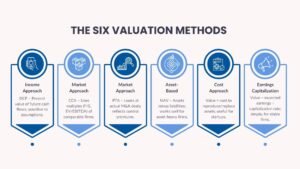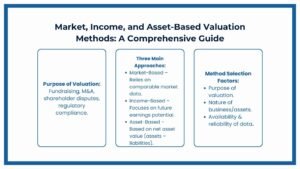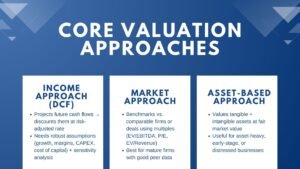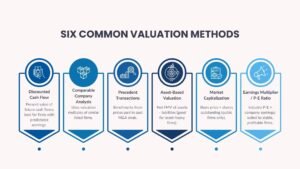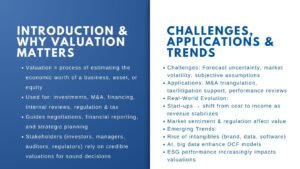
How 3 Key Company Valuation Approaches Are Applied in Practice
Learn How 3 Key Company Valuation Approaches Are Applied in Practice
Valuation is one of the most critical processes in finance, mergers and acquisitions, and strategic decision-making. Whether you are an investor deciding whether to acquire a company, a business owner preparing for a sale, or a financial analyst evaluating market potential, understanding how a company is valued is essential. The process is not just about assigning a number to a business; it is about capturing its economic worth in a way that is fair, reasonable, and backed by analytical rigor.
Three primary valuation approaches dominate professional practice: the market approach, the income approach, and the asset-based approach. Each method has its own theoretical foundation, data requirements, and practical applications. These approaches can lead to different results depending on the purpose of the valuation, the nature of the company, and prevailing market conditions. A skilled valuation professional often considers all three, weighing their relevance and reliability for the specific situation.
This article provides an in-depth explanation of the three approaches, including when and why they are used, their strengths and limitations, and the factors that influence the choice of method. By the end, you will have a clearer understanding of how valuation works and why no single method can claim universal superiority.
Understanding the Market Approach
The market approach determines a company’s value by comparing it to similar businesses whose value is already observable in the market. This can involve examining the prices at which comparable companies have been bought or sold, or using market multiples derived from publicly traded companies in the same sector.
One of the most widely used techniques under this approach is the comparable company analysis, where valuation ratios such as price-to-earnings (P/E), enterprise value-to-EBITDA (EV/EBITDA), or price-to-sales (P/S) are calculated for similar businesses. These multiples are then applied to the target company’s financial metrics to estimate its value. Another variation is the precedent transaction analysis, which looks at the prices paid in previous mergers or acquisitions of similar businesses, adjusting for factors such as transaction date, deal size, and industry trends.
The strength of the market approach lies in its reliance on real-world pricing. It reflects the actual amounts that investors are willing to pay in the current economic climate, making it highly relevant when the goal is to determine a fair market value. However, the accuracy of this method depends on the availability and quality of comparable data. In some industries—especially niche sectors or early-stage startups—finding truly comparable companies can be challenging. Market sentiment and temporary economic fluctuations can also distort values, sometimes leading to overvaluation in boom periods or undervaluation during downturns.
In practice, the market approach is often favored when there is sufficient and reliable market data, and when valuing companies in well-established industries with transparent transaction histories. It is less suitable when market data is scarce or when the subject company operates in a highly specialized or emerging market. For businesses seeking company valuation services in Singapore, working with certified company valuation specialists in Singapore ensures accuracy and compliance. Additionally, knowing how to choose valuation consulting services Singapore can help companies align their valuation approach with their strategic goals.
Understanding the Income Approach
The income approach values a company based on the economic benefits it is expected to generate in the future. Rather than looking at market comparisons, this method focuses on the intrinsic ability of the business to produce cash flow, profit, or other economic gains over time. The underlying principle is that a company’s value equals the present value of its expected future earnings, adjusted for risk.
The most common technique under the income approach is the discounted cash flow (DCF) method. This involves forecasting the company’s free cash flows over a certain projection period, estimating a terminal value for cash flows beyond that period, and then discounting all these amounts to their present value using an appropriate discount rate. The discount rate reflects the risk associated with achieving the projected cash flows, often derived from the company’s weighted average cost of capital (WACC).
The income approach is particularly useful when the company has stable and predictable cash flows, such as in mature industries or long-term contracts. It allows analysts to incorporate detailed assumptions about future growth, profitability, and risk, making it adaptable to different business models and scenarios. This method also provides insight into how operational improvements, cost efficiencies, or market expansions could affect value.
However, the income approach is highly sensitive to the quality of assumptions and inputs. Overly optimistic revenue projections, underestimated risks, or inappropriate discount rates can lead to significant misvaluations. Small changes in assumptions can result in large changes in the calculated value, which means transparency and rigorous analysis are essential. Despite these challenges, many professionals regard the income approach as one of the most theoretically sound valuation methods, especially for long-term investment analysis.
Understanding the Asset-Based Approach
The asset-based approach values a company based on the fair market value of its assets minus its liabilities. This method essentially answers the question: “If this company were liquidated today, what would its net assets be worth?” It is a balance-sheet-focused approach that considers tangible and intangible assets alike.
In its simplest form, the asset-based approach uses the book value of assets from the company’s financial statements, adjusting them to reflect current market values. In more complex applications, intangible assets such as intellectual property, trademarks, customer relationships, and goodwill are also appraised and included. For companies in asset-heavy industries such as manufacturing, transportation, or real estate, this method can provide a reliable baseline value.
The strength of the asset-based approach is its straightforwardness and its grounding in tangible, verifiable values. It is particularly relevant for businesses that are asset-intensive or for situations involving liquidation, bankruptcy, or restructuring. For example, a real estate investment trust (REIT) might rely heavily on asset-based valuations because its property holdings can be appraised with relative precision.
However, this method can underestimate the value of companies whose worth lies primarily in their earning potential rather than their physical or recorded assets. For technology firms, service businesses, or startups with strong growth prospects but few tangible assets, the asset-based approach may fail to capture their true economic value. It also requires careful and sometimes costly appraisals to adjust asset values to fair market levels, especially for unique or specialized assets.
Choosing the Right Approach
In real-world practice, valuation professionals rarely rely on just one approach. Instead, they often use multiple methods and then reconcile the results to arrive at a final value conclusion. The choice of approach depends on the purpose of the valuation, the nature of the business, the availability of data, and prevailing market conditions.
For example, an acquisition in a competitive and transparent industry might lean heavily on the market approach, supported by income approach analysis to confirm long-term viability. A high-growth technology startup with minimal tangible assets might rely primarily on the income approach, while an asset-heavy manufacturing company undergoing liquidation might be valued predominantly through the asset-based approach.
Purpose also matters. Valuations for regulatory compliance or financial reporting might have stricter requirements on methodology and documentation, whereas valuations for internal decision-making may allow for more flexibility and scenario analysis. Furthermore, market volatility, industry trends, and the company’s stage of development can shift the relevance of each method over time.

Final Thoughts
Understanding the three main company valuation approaches—the market approach, the income approach, and the asset-based approach—is fundamental for anyone involved in financial analysis, corporate transactions, or strategic planning. Each method offers a different lens through which to view a company’s worth, and each comes with its own advantages and limitations.
No method is universally superior, and the most accurate valuations often come from a balanced application of multiple approaches. Professional judgment, supported by reliable data and transparent assumptions, remains essential in ensuring that the resulting valuation is both credible and useful for its intended purpose.
In an increasingly complex business environment, where industries evolve quickly and market conditions can shift overnight, mastering these three approaches equips decision-makers with the analytical tools needed to make informed and strategic choices. Valuation, after all, is not just about numbers—it is about understanding the story those numbers tell, and the future they help to shape.


